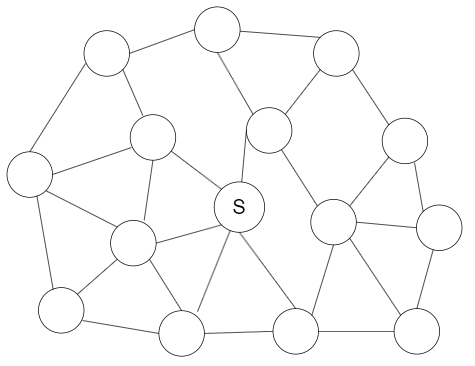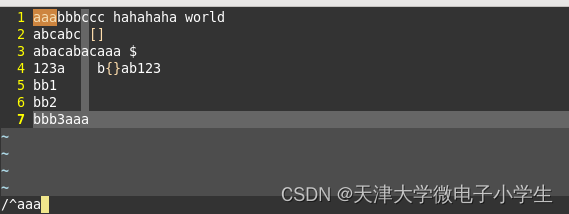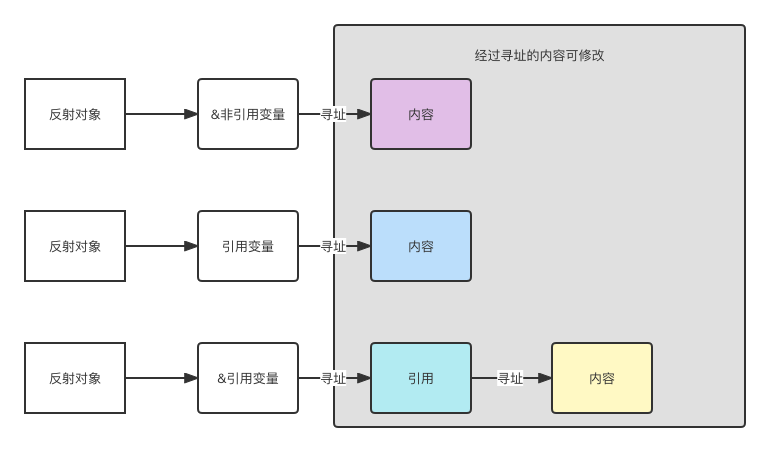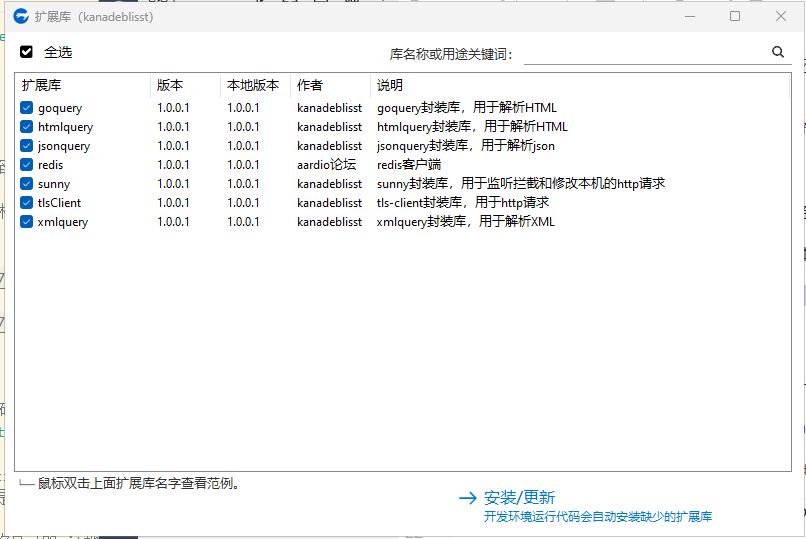要点回顾
- 继承自
std::enable_shared_from_this<T>的类能够在其自身实例中通过std::shared_from_this方法创建一个指向自己的std::shared_ptr<T>智能指针。 - 从一个裸指针创建多个
std::shared_ptr<T>实例会造成严重的后果,其行为是未定义的。 std::enable_shared_from_this<T>实际包含了一个用于指向对象自身的std::weak_ptr<T>指针。
引言
本文介绍 std::enable_shared_from_this 及 std::shared_from_this 的基本概念和使用方法。
定义 "std::enable_shared_from_this"
以下内容是 cppreference.com 上关于 std::enable_shared_from_this 的定义和说明:
Defined in header < memory >
template< class T > class enable_shared_from_this; (since C++11)
std::enable_shared_from_thisallows an object t that is currently managed by astd::shared_ptrnamed ptto safely generate additional std::shared_ptr instancespt1, pt2, ... that all share ownership of t with pt.Publicly inheriting from
std::enable_shared_from_this<T>provides the type T with a member functionshared_from_this. If an object t of type T is managed by astd::shared_ptr<T>named pt, then callingT::shared_from_thiswill return a newstd::shared_ptr<T>that shares ownership of t with pt.
简单来说就是,继承自 std::enable_shared_from_this<T> 的类能够在其自身实例中通过 std::shared_from_this 方法创建一个指向自己的 std::shared_ptr<T> 智能指针。
想要理解 std::enable_shared_from_this<T>,首先得知道为什么需要 std::enable_shared_from_this<T>,请看下文。
使用 "std::enable_shared_from_this"
为什么需要 std::enable_shared_from_this<T>? 我们从一个例子讲起,会更容易一些。
假定有一个类 Processor, 它的作用是异步处理数据并且存储到数据库。当 Processor 接收到数据时,它通过一个定制的 Executor 类型来异步处理数据:
class Executor {
public:
//Executes a task asynchronously
void
execute(const std::function<void(void)>& task);
//....
private:
/* Contains threads and a task queue */
};
class Processor {
public:
//...
//Processes data asynchronously. (implemented later)
void processData(const std::string& data);
private:
//Called in an Executor thread
void doProcessAndSave(const std::string& data) {
//1. Process data
//2. Save data to DB
}
//.. more fields including a DB handle..
Executor* executor;
};
Client 类包含了一个 std::shared_ptr<Processor> 实例,Processor 从 Client 类接收数据:
class Client {
public:
void someMethod() {
//...
processor->processData("Some Data");
//..do something else
}
private:
std::shared_ptr<Processor> processor;
};
以上示例中,Executor 是一个线程池,用于执行任务队列中的任务。
在 Processor::processData 中,我们需要传递一个(指针)函数(lambda 函数)给 Executor 来执行异步操作。该 lambda 函数调用 Processor::doProcessAndSave 以完成实际的数据处理工作。因此,该 lambda 函数需要捕获一个 Processor 对象的引用/指针。我们可以这样做:
void Processor::processData(const std::string& data) {
executor->execute([this, data]() { //<--Bad Idea
//Executes in an Executor thread asynchronously
//'this' could be invalid here.
doProcessAndSave(data);
});
}
然而,因为种种原因,Client 可能会随时重置 std::shared_ptr<Processor>,这可能导致 Processor 的实例被析构。因此,在执行 execute 函数时或者在执行之前,上述代码中捕获的 this 指针随时可能会变为无效指针。
怎么办?
我们可以通过在 lambda 函数中捕获并保留一个指向当前对象本身的 std::shared_ptr<Processor> 实例来防止 Processor 对象被析构。
下图展示了示例代码的交互逻辑:
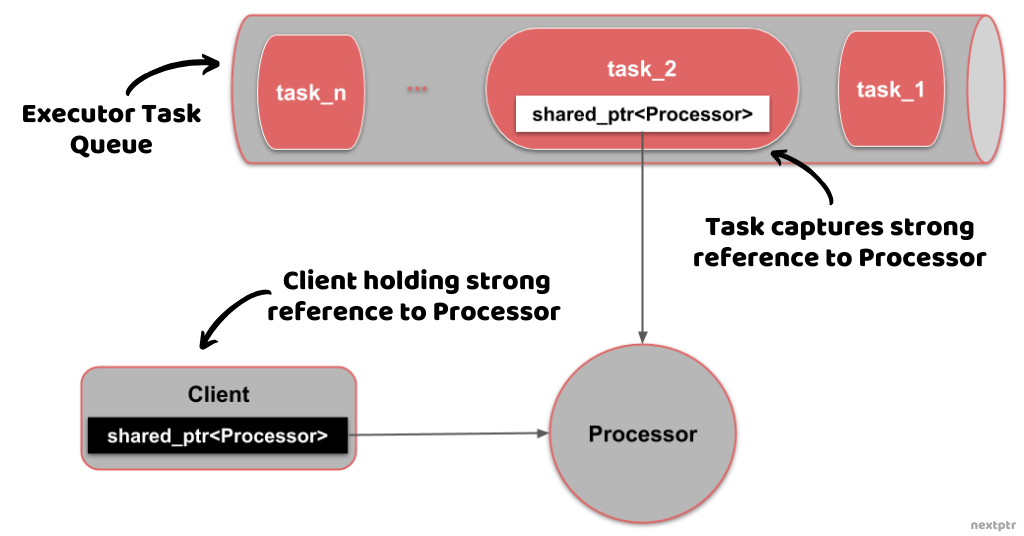
那么,在 Processor 实例中通过 shared_ptr
std::shared_ptr<T> 允许我们安全地访问和管理对象的生命周期。多个 std::shared_ptr<T> 实例通过一个共享控制块结构(a shared control block structure)来管理对象的生命周期。一个控制块维护了一个引用计数,及其他必要的对象本身的信息。
void good() {
auto p{new int(10)}; //p is int*
std::shared_ptr<int> sp1{p};
//Create additional shared_ptr from an existing shared_ptr
auto sp2{sp1}; //OK. sp2 shares control block with sp1
}
从一个裸指针创建一个 std::shared_ptr<T> 会创建一个新的控制块。从一个裸指针创建多个 std::shared_ptr<T> 实例会造成严重的后果:
void bad() {
auto p{new int(10)};
std::shared_ptr<int> sp1{p};
std::shared_ptr<int> sp2{p}; //! Undefined Behavior
}
因此,我们需要一个机制能够达到我们的目的(捕获并保留一个指向当前对象本身的 std::shared_ptr<Processor> 实例)。
这就是 std::enable_shared_from_this<T> 存在的意义,以下是修改后的类 Processor 实现:
class Processor : public std::enable_shared_from_this<Processor> {
//..same as above...
};
void Processor::processData(const std::string& data) {
//shared_from_this() returns a shared_ptr<Processor>
// to this Processor
executor->execute([self = shared_from_this(), data]() {
//Executes in an Executor thread asynchronously
//'self' is captured shared_ptr<Processor>
self->doProcessAndSave(data); //OK.
});
}
self = shared_from_this() 传递的是一个合法的 std::shared_ptr<Processor> 实例,合法的类 Processor 对象的引用。
深入 "std::enable_shared_from_this" 内部
std::enable_shared_from_this<T> 的实现类似:
template<class T>
class enable_shared_from_this {
mutable weak_ptr<T> weak_this;
public:
shared_ptr<T> shared_from_this() {
return shared_ptr<T>(weak_this);
}
//const overload
shared_ptr<const T> shared_from_this() const {
return shared_ptr<const T>(weak_this);
}
//..more methods and constructors..
//there is weak_from_this() also since C++17
template <class U> friend class shared_ptr;
};
enable_shared_from_this 包含了一个 std::weak_ptr<T> 指针,这正是函数 shared_from_this 返回的内容。注意,为什么不是 std::shared_ptr<T>? 因为对象包含自身的计数引用会导致对象永远不被释放,从而发生内存泄漏。上述代码中 weak_this 会在类对象被 std::shared_ptr<T> 引用时赋值,也就是std::shared_ptr<T> 实例的构造函数中赋值,这也是为什么类 enable_shared_from_this 的最后,其被声明成为了 shared_ptr 的友元。
总结
到此,关于 std::enable_shared_from_this<T> 的介绍就结束了。
引用
https://en.cppreference.com/w/cpp/memory/enable_shared_from_this
https://www.nextptr.com/tutorial/ta1414193955/enable_shared_from_this-overview-examples-and-internals



